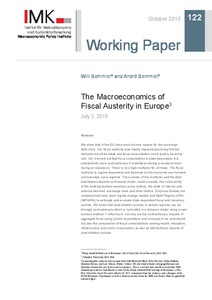The macroeconomics of fiscal austerity in Europe
"We show that in the EU there were diverse causes for the sovereign debt crisis. Yet, fiscal austerity was hastily imposed assuming that the multiplier would be weak and fiscal consolidation could quickly be achieved. Yet, it turned out that fiscal consolidation is state dependent: It is substa...
| Main Authors: | , |
|---|---|
| Institution: | ETUI-European Trade Union Institute |
| Format: | TEXT |
| Language: | German |
| Published: |
Düsseldorf
2013
IMK |
| Subjects: | |
| Online Access: | https://www.labourline.org/KENTIKA-19123924124919411069-The-macroeconomics-of-fiscal-a.htm |
| Summary: | "We show that in the EU there were diverse causes for the sovereign debt crisis. Yet, fiscal austerity was hastily imposed assuming that the multiplier would be weak and fiscal consolidation could quickly be achieved. Yet, it turned out that fiscal consolidation is state dependent: It is substantially more contractionary if undertaken during a recession than during an expansion. There is no single multiplier for all times. The fiscal multiplier is regime dependent and depends on the economic environment and business cycle regimes. The success of the multiplier and the debt stabilization depend on financial stress, credit spreads, the vulnerability of the banking system,monetary policy actions, the state of internal and external demand, exchange rates and other factors. Empirical studies are reviewed that have used regime change models and Multi-Regime VARs (MRVARs) to estimate and evaluate state dependent fiscal and monetary policies. We show that consolidation policies in certain regimes can be strongly contractionary which is replicated in a dynamic model using a new solution method. Furthermore, not only are the contractionary impacts of aggregate fiscal policy (public expenditure and revenue) to be considered, but also the composition of fiscal consolidations aecting health, education, infrastructure and public consumption as well as distributional impacts of consolidation policies." |
|---|---|
| Physical Description: | 39 p. Digital |

